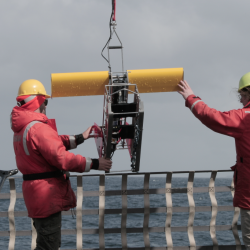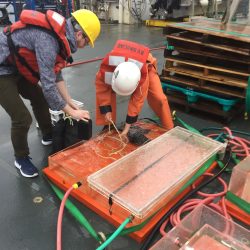Lauren Frisch, Public Information Officer for the College of Fisheries and Ocean Sciences, UAF, authored a series of four stories about our May 2018 cruise. Although these stories focus on the on-board capabilities of R/V Sikuliaq, they also include engaging descriptions of our research. Find the links to these stories below:
Sikuliaq expands ways to study Gulf of Alaska ecosystems |
|

|
Studies of zooplankton such as copepods have expanded because of LTER funding and the workspace available aboard R/V Sikuliaq. For instance, CFOS researcher Russ Hopcroft isolates, identifies, photographs, and assesses live animals soon after net tows. Read full story >> |
Submarine ‘airplane’ revolutionizes measurement of seawater content |
|

|
CFOS’s Seth Danielson operates an Acrobat instrument, which he described as the underwater version of an airplane. The Acrobat measures temperature and salinity on fine spatial scales. As a result, LTER scientists can track freshwater from the land and investigate how it mixes with ocean water. Read full story >> |
Sikuliaq improves analysis of phytoplankton’s nutrient needs |
|

|
CFOS’s Ana Aguilar-Islas brings her own specialized clean sampling instruments onto Sikuliaq so she can quantify nutrients like iron that are essential to phytoplankton. Additionally, Aguilar-Islas and WWU’s Suzanne Strom performed incubation experiments to study how iron availability affects plankton growth. Read full story >> |
Sikuliaq researchers find odd, abundant animal-plant plankton |
|

|
Nutritional flexibility in ciliates and dinoflagellates stabilizes food chains in the Gulf of Alaska. WWU’s Suzanne Strom isolates cells and preserves them soon after they are collected, so she can analyse them at sea and in her onshore lab. Read full story >> |
